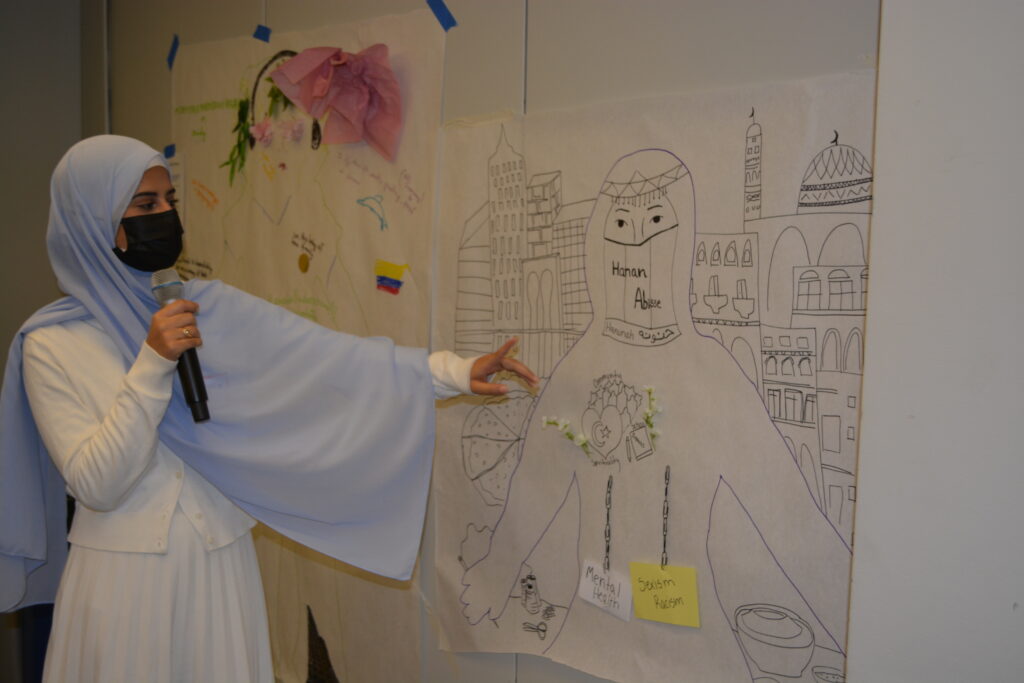
On Friday 10/14 CUNY Peer Leaders gathered to participate in a Body Mind Mapping exercise. What is Body Mind Mapping you might ask? I was first introduced to Body Mind Mapping at the MURAP 2019 Conference at UNC-Chapel Hill. A group of researchers talked about using Body Mind Mapping as a methodology in order to find a deeper connection to the Latin-American and Indigenous community in Colombia. I remember seeing photographs of community members’ bodies traced on giant white paper. These outlined bodies were then decorated with various crafts and colors that detailed the stories, lived experiences, and trauma they carried in such an artistic way.
Body Mind Mapping was developed in 2008 with the Canadian AID Treatment Information Exchange and the Regional Psychosocial Support Initiative in South Africa. In order to understand and navigate stigmas on HIV/AIDS, Body Mind Mapping aimed to recognize and elevate the stories and experiences of those diagnosed. Since then activists have come together to develop workshops on body mapping for health, wellness, and experiences. When I came across Body Mind Mapping, I saw this as an important opportunity to highlight the experiences of my own students, dive into pedagogical practices that were different from conventional traditions of learning and documentation, and show a creative outlet where students could feel connected and empowered with their bodies.
I tend to use body-mind mapping as a leadership exercise and an icebreaker to learn about my students and fellow peers. As a participant myself in these activities, I also take the opportunity to reflect on my own conceptualizations of my identity and aspirational goals as well. Nothing about being human is static. Therefore, I highly encourage those facilitating the activity to also participate. The self-reflection is worth it and illuminating. Students work together by having a partner trace the outline of their bodies on a giant piece of paper. If students are not comfortable with this, we also have the option to use a printable of a body on standard-sized paper.

For the CUNY Peer Leaders, I developed a series of guiding questions that students could respond to on their body-mind maps. Abstract interpretation is encouraged. Our overall goal is for participants to describe on their bodies who they are, what they are feeling, what they desire, and what they hope for. Here are a few examples:
- * Write down your name anywhere on your body map. What do you like people to call you? How do YOU spell it? How do YOU pronounce it? Do you have any nicknames? or specific ways of spelling?
- * Loaded question: Where are you from? Think in terms of space, city, and any location that YOU feel represents where you are from. This can be cultural too. Maybe you’re from many places? What does that look like?
- * What brings you peace? What are some things that make you feel relaxed and with yourself? I.e. reading a book, playing an instrument, bubble baths? What are some spaces that break your peace or make you feel relaxed?

Over the years, the questions develop or expand. Depending on the group, students are able to share as much as they want to. The group is encouraged to bring crafts and colored pencils to make the activity as mixed-media and sensory as possible. With the CPL we did this and had our students bring newspaper clippings, magazines, pom poms, colorful paper, and glitter. My goal is to things back to Kindergarten. Hands-on activities are a rare occurrence in the collegiate setting, and yet truly memorable.
Some students drew connections to their immigrant background and growing up in New York City. Others highlighted their inquisitive nature by composing a body map with questions about identity and career. I was especially moved by a student who drew a dolphin in connection with and remembrance of their grandmother! always in awe of the creativity and insight that comes from our participants. Perhaps it is an educator mindset in me, but I cherish opportunities where our students are able to explain connections to their loved ones, their aspirations, and what is stressing them out. How can we get to know our students better?

Thank you to our wonderful students for sharing their body maps! You are all truly inspiring.


